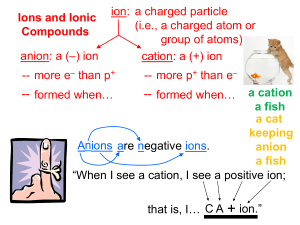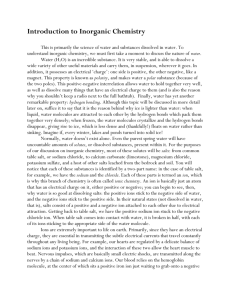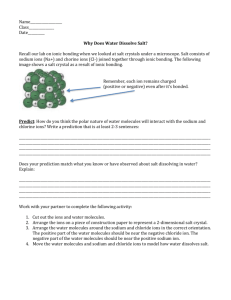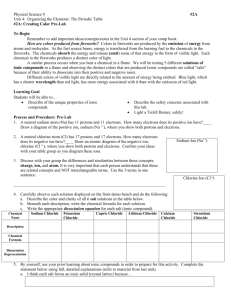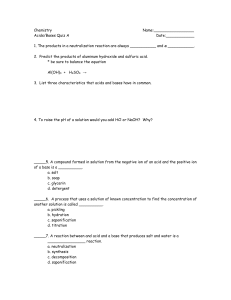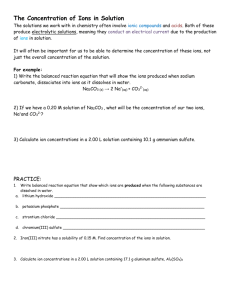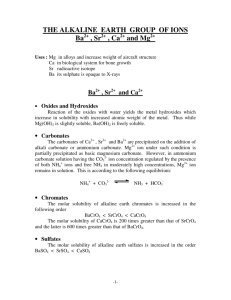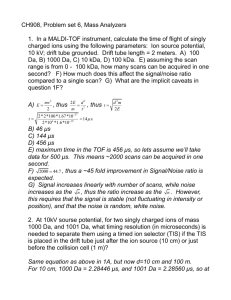Assignment 2 unknown
advertisement
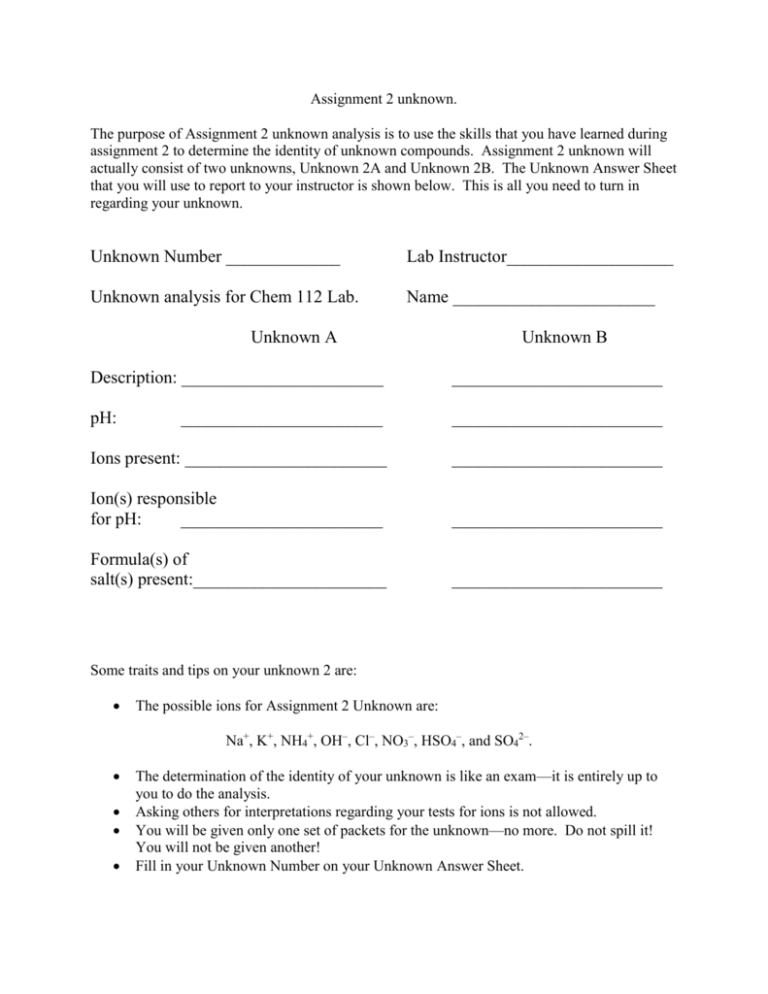
Assignment 2 unknown. The purpose of Assignment 2 unknown analysis is to use the skills that you have learned during assignment 2 to determine the identity of unknown compounds. Assignment 2 unknown will actually consist of two unknowns, Unknown 2A and Unknown 2B. The Unknown Answer Sheet that you will use to report to your instructor is shown below. This is all you need to turn in regarding your unknown. Unknown Number _____________ Lab Instructor___________________ Unknown analysis for Chem 112 Lab. Name _______________________ Unknown A Unknown B Description: _______________________ ________________________ pH: _______________________ ________________________ Ions present: _______________________ ________________________ Ion(s) responsible for pH: _______________________ ________________________ Formula(s) of salt(s) present:______________________ ________________________ Some traits and tips on your unknown 2 are: The possible ions for Assignment 2 Unknown are: Na+, K+, NH4+, OH–, Cl–, NO3–, HSO4–, and SO42–. The determination of the identity of your unknown is like an exam—it is entirely up to you to do the analysis. Asking others for interpretations regarding your tests for ions is not allowed. You will be given only one set of packets for the unknown—no more. Do not spill it! You will not be given another! Fill in your Unknown Number on your Unknown Answer Sheet. You may use your lab information, notes and a Scheme of Analysis when you perform your unknown analysis. The unknown will be composed of two packets, each containing one or more solid salts. Unknown 2A is guaranteed to be a pure salt. Unknown 2B can be a mixture of one to three separate salts. Unknown 2B will not contain a salt of SO42– mixed with a salt of HSO4–. Mixtures of salts for Unknown 2B will be pH compatible. You will not be given a salt of a strong base mixed with a salt of a weak or strong acid. Ideally, you will test for individual ions in each sample—do not mix the samples up (confuse A for B)! After you test each sample for all of the ions, you should fill in all of the questions on your Unknown Answer Sheet. Most of the points you receive from your Unknown Analysis come from the part “Ions Present” on your Unknown Answer Sheet. Your score on this question will be based on the number of correct answers and the number of incorrect answers. Correct answers are ions that you write that are in your sample. Incorrect answers are ions written down that are not in the sample and ions that are in the sample that are not written down. There is a time limit of 1 hour and 45 minutes for the unknown—so work diligently. After your unknown, start working on the lab—lab time is too valuable to waste. Give left over unknown to your instructor. If you decide to challenge your grade, there must be some unknown to test to meet your challenge. Mix Unknown 2B well, breaking up any chunks if possible. You will need to be able to distinguish the difference between HSO4– and SO42–. There is a possibility that Na+ may be in a sample as an impurity. You must be able to distinguish between Na+ being present as a “trace element” (impurity) or as one of the ions in the sample as a salt. This should be done based on the “strength” of the yellow color during the flame test. If Na+ is there as an impurity, it should not be reported. For many of the tests for the ions, you will need to prepare a solution from your unknown sample. Do any tests directly on the solid unknown if possible to avoid the possibility of contamination during processing. For example, the flame test works well on the solid or a solution. Do the flame test on the solid unless you suspect that Na+ is there as an impurity. Also, the test for NH4+ can be done on the solid. Be aware and flexible on your determinations as the conditions that your unknown sample is in may be slightly different than the test solutions you used throughout Assignment 2. For example, your unknown solution may only be 0.07 M or maybe 0.15 M in an ion when the ion was at 0.1 M when you first tried the test during the Assignment 2. Be aware that the DI water can be somewhat acidic—usually a pH of 5.5 to 6. Under the reason for pH, if the solution is acidic because of a specific ion, state which ion. Scheme of Analysis for Unknown 2 Possible ions: Na+, K+, NH4+, OH–, Cl–, NO3–, HSO4–, and SO42–. Step 1: Fill in my unknown number and name. Step 2: Describe the unk. Step 3: Do the flame test. If yellow for a long time, report Na+. K+ is not present. NH4+ is inconclusive. If blue or purple, report K+. Na+ is not present. NH4+ is inconclusive. If no color or only a brief yellow flair-up is visible, K+ and Na+ are not present. Look for a positive NH4+ test. Step 4: Do the test for NH4+ ion on a rice-sized portion of unknown solid as described in Q 2-16. Step 5: If have Na+ and NH4+, and don’t know about K+, put small sample in crucible, assemble hood, volatilize off the NH4+ -- containing salt and test for K+ using the cobaltinitrite test. This is described in section 4. Step 6: Make a solution by dissolving about half of my unknown sample into 15 to 20 mL of DI water. Step 7: Determine the pH of the solution using the pHydrion paper or pH meter. Report the pH to one significant digit beyond the decimal (to the right of it). Step 8: If the pH is 12 to 13, report OH– ion. If the pH is between 9 and 11, there’s a problem. Step 9: If there was a possibility of Na+ contamination as evidenced by a brief yellow flare-up during the flame test, do the flame test on the solution to double check. Step 10: If had Na+ and did not have NH4+, do the cobaltinitrite test for K+ on a small portion of the unknown solution. Step 11: Perform the Ferrous Sulfate test for NO3– ion as described in section 10. If positive for NO3–, report NO3–. Step 10: Acidify 1 to 2 mL of unknown using HNO3 if the unknown solution is not already acidic. Split this acidified solution up into two test tubes. a. Test half of the acidified solution (one test tube) for Cl– using the silver nitrate solution as described in section 7. If positive, report Cl–. b. Test the other half of the acidified solution for HSO4– or SO42– using Ba(NO3)2 as described in section 8. 1. If the test is positive and the pH as determined in Step 7 was very low, like less than 2.5, report HSO4– ion. 2. If the test is positive and it was determined in Step 7 that the pH was not very low, like higher than 4, report SO42– ion. Step 11: Finish filling in the questions, make sure I put the unknown number on the proper line and my on the sheet and turn it in.
